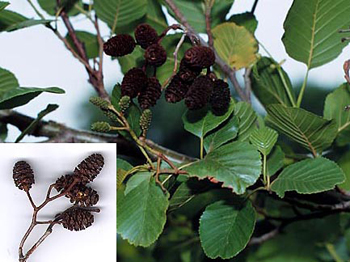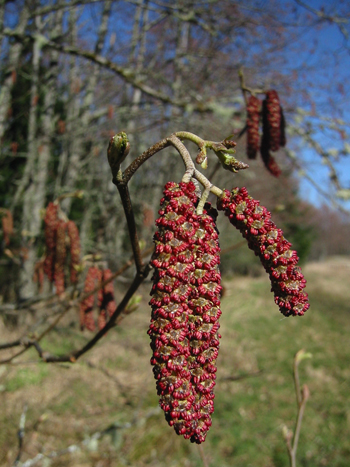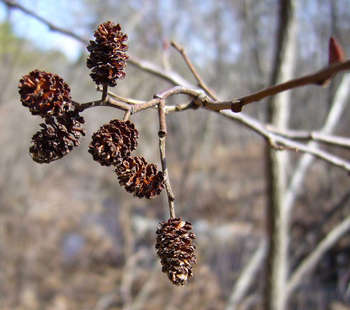Contents:
Common Names | Parts Usually Used | Plant(s) & Culture | Where Found | Medicinal Properties
Legends, Myths and Stories | Uses | Formulas or Dosages | Bibliography
Scientific Names

Black Alder |
- Alnus glutinosa L.
- Alnus rubra L.
- Aquifoliaceae
- Betulaceae
- Birch family
Common Names
- Black alder
- European alder
- Fever bush
- Owler
- Red Alder
- Smooth Alder
- Winter berry
Parts Usually Used
Bark, leaves
Back to Top
Description of Plant(s) and Culture

Red Alder |
Black alder (A. glutinosa) is a deciduous tree up to 80 feet high; the alternate leaves are round-obovate, usually doubly serrate, scalloped, and have a tuft of down on the underside. The flowers are segregated by sex into separate catkins, the reddish-purple female ones developing into hard cones that contain the seeds. 2-8 catkins will occur in a cluster on a forked peduncle.
Red alder (A. rubra) grows as a shrub or tree. It has elliptic-ovate leaves that are dark green on top and rusty-haired underneath. Found in evergreen and redwood forests from Northern California to Alaska. Uses and dosage is the same as A. glutinosa.
Smooth alder (A. serrulata) sometimes called the Hazel alder, is a shrub or tree with blackish bark that is lightly speckled with small, grayish to orange lenticels. Its leaves are elliptic to obovate, finely serrate and usually fine-haired underneath. It can be found from Nova Scotia to Oklahoma, Florida, and Louisiana. Medicinally used the same as black alder.
Back to Top
Where Found

Smooth Alder |
Black alder (A. glutinosa) grows in Europe, Asia, North Africa, and locally in North America. Found in cooler regions, forming dense stands around swamps and along streams and rivers. Cool, moist or even wet soils.
Back to Top
Medicinal Properties
Astringent, bitter tonic, emetic, hemostatic, mucilaginous, cathartic, alterative
Back to Top
Legends, Myths and Stories
Culpeper states: “The said leaves gathered while the morning dew is on them, and brought into a chamber troubled with fleas, will gather them there unto, which being suitably cast out, will rid the chamber of these troublesome fellows.”
Native Americans sometimes dyed basket grass with alder bark in a brilliant burnt orange shade, which fades with age to a rich brown.
Back to Top
Uses
Fresh alder bark will cause vomiting; so use dried bark for other than emetic purposes. A decoction of the bark makes a good gargle for sore throat and pharyngitis. The powdered bark and the leaves have been used as a tonic. Boiling the inner bark in vinegar produces an external wash for lice and for skin problems such as scabies and scabs, psoriasis, rheumatism, inflammations, good for burning and aching feet, dropsy, shingles, impetigo, pruritis, poultice for swellings of all kinds including enlarged glands, scrofula. You can use the liquid to clean your teeth and firm gums. An effective worm medicine for children. Inner bark boiled in vinegar will kill lice, cure the itch, cures old sores, and good for toothache.
Back to Top
Formulas or Dosages
Infusion: use
Decoction: boil
Tincture: a dose is from
Powder: a dose is from
Poultice: use just enough water to moisten the leaves.
Back to Top
Bibliography
![]() The Herb Book
The Herb Book, by John Lust, Bantam Books, 666 Fifth Avenue, New York, NY. copyright 1974.
![]() Culpeper’s Complete Herbal & English Physician: Updated With 117 Modern Herbs
Culpeper’s Complete Herbal & English Physician: Updated With 117 Modern Herbs, by Nicholas Culpeper, Meyerbooks, publisher, PO Box 427, Glenwood, Illinois 60425, 1990, (reprint of 1814)
![]() The Herbalist Almanac
The Herbalist Almanac, by Clarence Meyer, Meyerbooks, publisher, PO Box 427, Glenwood, Illinois 60425, copyright 1988, fifth printing, 1994
![]() Indian Uses of Native Plants
Indian Uses of Native Plants, by Edith Van Allen Murphey, Meyerbooks, publisher, PO Box 427, Glenwood, Illinois 60425, copyright 1958, print 1990
![]() Eastern/Central Medicinal Plants
Eastern/Central Medicinal Plants, by Steven Foster and James A. Duke., Houghton Mifflin Company, 215 Park Avenue South, New York, NY 10000
 The Magic of Herbs
The Magic of Herbs, by David Conway, published by Jonathan Cape, Thirty Bedford Square, London, England. (Out of print)
![]() Indian Herbalogy of North America
Indian Herbalogy of North America, by Alma R. Hutchens, Shambala Publications, Inc., Horticultural Hall, 300 Massachusetts Avenue, Boston, Massachusetts 02115, 1973
![]() Webster’s New World Dictionary
Webster’s New World Dictionary, Third College Edition, Victoria Neufeldt, Editor in Chief, New World Dictionaries: A Division of Simon & Schuster, Inc., 15 Columbus Circle, New York, NY 10023
 How Indians Use Wild Plants for Food, Medicine & Crafts
How Indians Use Wild Plants for Food, Medicine & Crafts, by Frances Densmore, Dover Publications, Inc., 180 Varick Street, New York, NY 10014, first printed by the United States Government Printing Office, Washington, in 1928, this Dover edition 1974
 The Rodale Herb Book: How to Use, Grow, and Buy Nature’s Miracle Plants (An Organic gardening and farming book)
The Rodale Herb Book: How to Use, Grow, and Buy Nature’s Miracle Plants (An Organic gardening and farming book), edited by William H. Hylton, Rodale Press, Inc. Emmaus, PA, 18049., 1974
